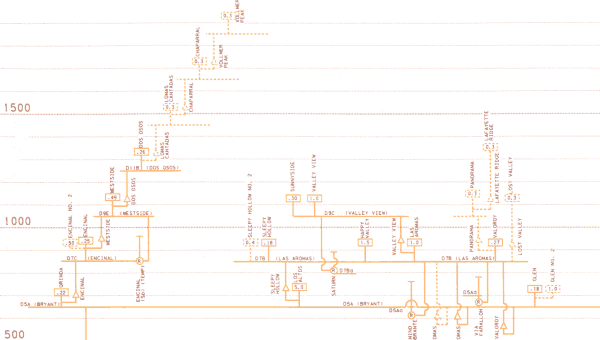© 2001 Capt. Willis Lamm, Water Supply Officer, Moraga-Orinda (CA) Fire District |
|
Most communities are located on relatively flat terrain. Water
storage is provided by a reservoir located on a nearby hillside or
by one or more water towers. Water pressure is provided by the
gravitational weight of the water, commonly referred to as "head."
The amount of water pressure available depends primarily on the difference in elevation between the stored water and the point at which the water is being used. Water pressure increases by .434 pounds for every foot of elevation difference. Therefore a flat community with a 150 ft. tall water tower would expect to have about 65 pounds of water pressure at ground level. Water delivery becomes more complicated in hillside communities. The East Bay Municipal Utility District (EBMUD) distribution system covers over 1500 feet of elevation changes throughout the Oakland-Berkeley hills. If all water storage was kept at the highest point of the system, water pressure at the lower levels would be about 650 p.s.i. and the cost of pumping the water supply to such a high storage elevation would be prohibitive. To provide water to hillside communities, the distribution system has to be stratified into multiple zones with each zone serving a specific elevation area. This stratified design is known as a "cascade system." Each zone is served by one or more reservoirs and is its own self-contained distribution system. Reservoirs are designed to provide at least two days of domestic consumption plus have a reserve capacity to provide between two and three hours of required fire flow. Water is pumped upwards through the cascade system from the Orinda Filter Plant in the valley floor. It moves from the filter plant to the first pressure zone, then a series of pump plants carry the water upward from each zone to the one above it. Water provided for fire fighting is primarily provided by storage. For a variety of reasons, the pumps are designed to refill the reservoirs daily, usually at night when electrical demand is lightest and electric rates are lowest. Since the reservoirs are sized for two days' consumption plus fire flow storage, pumping at night is a sensible practice. (During very high fire danger weather pumps will remain active during the day to keep all critical reservoirs full.) Pumps at the lower portion of the cascade are sized to provide the necessary volume for all the reservoirs above them in the cascade. Pumps in the upper levels of the cascade system are smaller as the water passing through them is destined for fewer reservoirs. Provisions are in place to redundant capability in the event of a pump plant failure. Some zones have more than one pump plant and other zones have emergency pump-around capabilities. There are also valves located in the system which tie the zones together. An EMBUD Supervisor will respond to all significant fires. In the event of a major incident in one of the intermediate zones which threatens to deplete the reservoir for that zone, water can be released from the next highest zone in controlled amounts in order to extend fire fighting capabilities. The EBMUD Cascade System
To learn more about EBMUD's water supply system, check out EBMUD's
Return to Water Supply IndexBack to Information Section |
|
Unless otherwise noted, all contents of these WWW pages © 1996-01, FireHydrant.org |